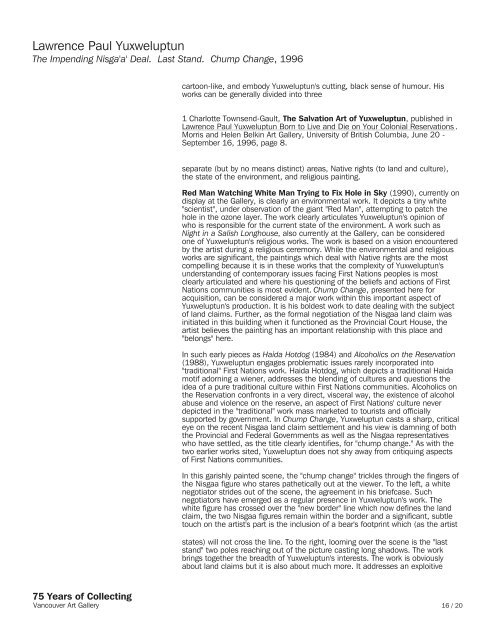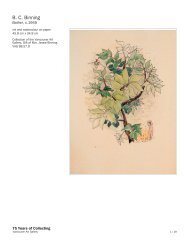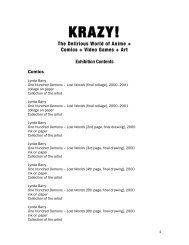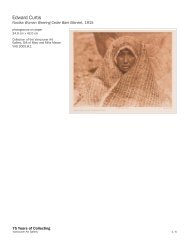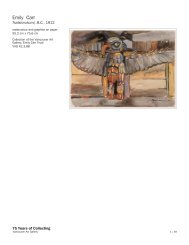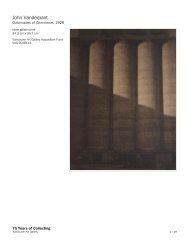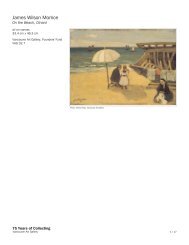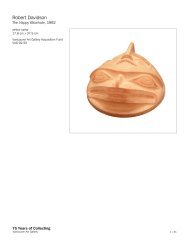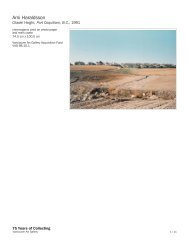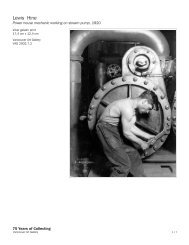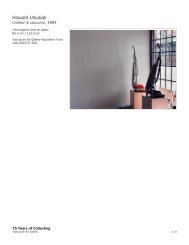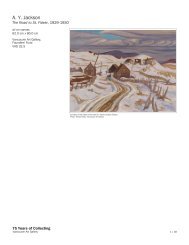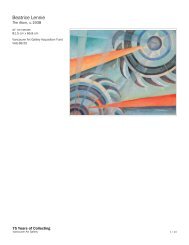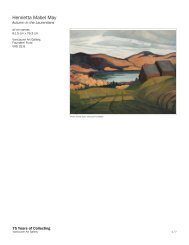Lawrence Paul Yuxweluptun - 75 Years of Collecting - Vancouver ...
Lawrence Paul Yuxweluptun - 75 Years of Collecting - Vancouver ...
Lawrence Paul Yuxweluptun - 75 Years of Collecting - Vancouver ...
Create successful ePaper yourself
Turn your PDF publications into a flip-book with our unique Google optimized e-Paper software.
<strong>Lawrence</strong> <strong>Paul</strong> <strong>Yuxweluptun</strong><br />
The Impending Nisga'a' Deal. Last Stand. Chump Change, 1996<br />
<strong>75</strong> <strong>Years</strong> <strong>of</strong> <strong>Collecting</strong><br />
<strong>Vancouver</strong> Art Gallery<br />
cartoon-like, and embody <strong>Yuxweluptun</strong>'s cutting, black sense <strong>of</strong> humour. His<br />
works can be generally divided into three<br />
1 Charlotte Townsend-Gault, The Salvation Art <strong>of</strong> <strong>Yuxweluptun</strong>, published in<br />
<strong>Lawrence</strong> <strong>Paul</strong> <strong>Yuxweluptun</strong> Born to Live and Die on Your Colonial Reservations .<br />
Morris and Helen Belkin Art Gallery, University <strong>of</strong> British Columbia, June 20 -<br />
September 16, 1996, page 8.<br />
separate (but by no means distinct) areas, Native rights (to land and culture),<br />
the state <strong>of</strong> the environment, and religious painting.<br />
Red Man Watching White Man Trying to Fix Hole in Sky (1990), currently on<br />
display at the Gallery, is clearly an environmental work. It depicts a tiny white<br />
"scientist", under observation <strong>of</strong> the giant "Red Man", attempting to patch the<br />
hole in the ozone layer. The work clearly articulates <strong>Yuxweluptun</strong>'s opinion <strong>of</strong><br />
who is responsible for the current state <strong>of</strong> the environment. A work such as<br />
Night in a Salish Longhouse, also currently at the Gallery, can be considered<br />
one <strong>of</strong> <strong>Yuxweluptun</strong>'s religious works. The work is based on a vision encountered<br />
by the artist during a religious ceremony. While the environmental and religious<br />
works are significant, the paintings which deal with Native rights are the most<br />
compelling because it is in these works that the complexity <strong>of</strong> <strong>Yuxweluptun</strong>'s<br />
understanding <strong>of</strong> contemporary issues facing First Nations peoples is most<br />
clearly articulated and where his questioning <strong>of</strong> the beliefs and actions <strong>of</strong> First<br />
Nations communities is most evident. Chump Change, presented here for<br />
acquisition, can be considered a major work within this important aspect <strong>of</strong><br />
<strong>Yuxweluptun</strong>'s production. It is his boldest work to date dealing with the subject<br />
<strong>of</strong> land claims. Further, as the formal negotiation <strong>of</strong> the Nisgaa land claim was<br />
initiated in this building when it functioned as the Provincial Court House, the<br />
artist believes the painting has an important relationship with this place and<br />
"belongs" here.<br />
In such early pieces as Haida Hotdog (1984) and Alcoholics on the Reservation<br />
(1988), <strong>Yuxweluptun</strong> engages problematic issues rarely incorporated into<br />
"traditional" First Nations work. Haida Hotdog, which depicts a traditional Haida<br />
motif adorning a wiener, addresses the blending <strong>of</strong> cultures and questions the<br />
idea <strong>of</strong> a pure traditional culture within First Nations communities. Alcoholics on<br />
the Reservation confronts in a very direct, visceral way, the existence <strong>of</strong> alcohol<br />
abuse and violence on the reserve, an aspect <strong>of</strong> First Nations' culture never<br />
depicted in the "traditional" work mass marketed to tourists and <strong>of</strong>ficially<br />
supported by government. In Chump Change, <strong>Yuxweluptun</strong> casts a sharp, critical<br />
eye on the recent Nisgaa land claim settlement and his view is damning <strong>of</strong> both<br />
the Provincial and Federal Governments as well as the Nisgaa representatives<br />
who have settled, as the title clearly identifies, for "chump change." As with the<br />
two earlier works sited, <strong>Yuxweluptun</strong> does not shy away from critiquing aspects<br />
<strong>of</strong> First Nations communities.<br />
In this garishly painted scene, the "chump change" trickles through the fingers <strong>of</strong><br />
the Nisgaa figure who stares pathetically out at the viewer. To the left, a white<br />
negotiator strides out <strong>of</strong> the scene, the agreement in his briefcase. Such<br />
negotiators have emerged as a regular presence in <strong>Yuxweluptun</strong>'s work. The<br />
white figure has crossed over the "new border" line which now defines the land<br />
claim, the two Nisgaa figures remain within the border and a significant, subtle<br />
touch on the artist's part is the inclusion <strong>of</strong> a bear's footprint which (as the artist<br />
states) will not cross the line. To the right, looming over the scene is the "last<br />
stand" two poles reaching out <strong>of</strong> the picture casting long shadows. The work<br />
brings together the breadth <strong>of</strong> <strong>Yuxweluptun</strong>'s interests. The work is obviously<br />
about land claims but it is also about much more. It addresses an exploitive<br />
16 / 20


